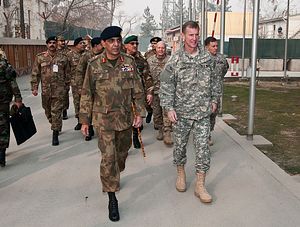While the U.S. and Pakistani counterterrorism efforts have degraded al-Qaeda and the Pakistani Taliban in the Federally Administered Tribal Areas (FATA), sectarian violence across the country continues unabated and threatens to further destabilize Pakistan and the broader region.
On March 31, in the latest episode of attacks against Pakistan’s Shia minority, at least 22 people were killed and more than 100 injured in a bomb blast that apparently targeted a Shia women’s mosque in Parachinar, the capital of FATA’s Kurram Agency bordering Afghanistan. The Jammat-ul-Ahrar (JuA), a branch of the banned Tehrik-i-Taliban Pakistan (TTP), claimed credit for the carnage. Parachinar’s majority Shia population has repeatedly been targeted by sectarian Punjabi outfits as well as Taliban militants that use the city as a corridor to enter Afghanistan. In January, another attack in the area – claimed by the TTP and a faction of Lashkar-e-Jhangvi (LeJ) – killed and injured more than 100, mainly Shia Muslims.
Sectarian strife is not a new phenomenon in Pakistan. While the Sunni-Shia divide was negligible during the first three decades of Pakistan’s existence (1947-77), the 1979 revolution in Iran and the Islamization policies of Pakistani military dictator Muhammad Zia-ul-Haq (1977-88) radicalized Pakistani Sunnis and Shias alike and set the stage for ceaseless sectarian violence in the country throughout the 1980s and 1990s. After the 2001 U.S. intervention in Afghanistan, there was a lull in sectarian attacks in Pakistan, as then-President Pervez Musharraf banned most Sunni and Shia militant and sectarian groups. But Musharraf’s crackdown proved to be more a tactical gesture to impress Washington than a genuine effort to clamp down on terrorism and sectarianism at home; his government soon released most of the 2,000 militants associated with banned terrorist and sectarian outfits.
Nor has the return of democracy after Musharraf helped tackle sectarian terrorism in Pakistan. Since 2008, successive civilian governments have largely delegated major internal security matters to the military establishment; and even worse, some provincial and local officials have at times partnered with sectarian organizations for political expediency. Although Pakistan’s 2014 Zarb-e Azb military operations in FATA and counterterrorism operations in the provinces of Punjab, Sindh, and Balochistan the following year yielded some positive results, the latest upsurge in violence shows anti-state and sectarian outfits are resilient. According to the South Asia Terrorism Portal (SATP), at least 440 Pakistanis have been killed and injured in sectarian attacks across the country this year – already surpassing the casualty numbers for all 2016. And sectarian attacks have not been confined to the tribal regions; Shia communities in Quetta, the capital of Balochistan Province, and Karachi, Pakistan’s largest city and financial hub, have taken the brunt of escalating attacks.
What makes the latest upsurge in anti-Shia violence in Pakistan different, however, is the spillover effects of the Syrian war. In recent years, Pakistani Sunni and Shia Muslims have been fighting on the opposing sides of Middle Eastern conflicts. Hundreds of Pakistani Sunnis have reportedly joined radical rebel groups in Syria, including the Islamic State, while Iran’s Revolutionary Guard has recruited, trained, and deployed large numbers of Pakistani and Afghan Shias to defend the embattled regime of Bashar al-Assad. Just days before the Parachinar attack in January, Pakistani security officials had warned that militants returning from Syria were planning attacks inside Pakistan. And when LeJ took responsibility for another deadly bombing in Parachinar in December 2015, it told news agencies that it was an act of “revenge for the killing of Muslims by the Syrian president and Iran.” Likewise in in neighboring Afghanistan, the Islamic State’s Khorasan branch has recently attacked rallies and religious ceremonies of Shia Hazaras. The problem could get even worse once battle-hardened Pakistani and Afghan militants, with poisonous sectarian beliefs, return home after the Syria war is over.
So far, a great majority of Pakistan’s Shia community – as in Afghanistan – have shown remarkable patience, resisted Iranian interference, shunned violence, and continued to be part of mainstream political parties. But the rising tide of attacks against Pakistan’s Shias and the government’s inability, or at times unwillingness, to tackle the problem leave young Shias vulnerable to radicalization and foreign meddling.
To address sectarian strife, Pakistan’s political and military leaders must devise and implement a comprehensive strategy that should include closing pro-militancy religious seminaries, reforming the education system, curbing foreign funding to extremist groups, and promoting de-radicalization and interfaith programs. To eliminate the scourge of terrorism and sectarianism in the region also requires Islamabad to sincerely cooperate with Kabul and Washington to jointly address the common threat.
The United States and its allies must not ignore the danger of sectarianism in Pakistan. Sunni sectarian groups not only massacre Pakistani Shias, but have also established close linkages with al-Qaeda and other regional and international terrorist organizations, and are actively involved in terrorist attacks in Afghanistan and India. Left unchecked, Sunni-Shia violence could further destabilize nuclear-armed Pakistan, with dangerous ramifications for regional stability and American national security.
Ahmad Majidyar is a Fellow and the Director of the IranObserved Project at the Middle East Institute. He also teaches senior U.S. military officers on security and politics in Afghanistan and Pakistan. The views expressed are his own.

































